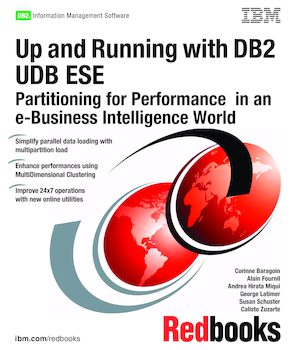Up and Running with DB2 UDB ESE: Partitioning for Performance in an e-Business Intelligence World
An IBM Redbooks publication
Note: This is publication is now archived. For reference only.

Published on 24 March 2003
ISBN-10: 0738429309
ISBN-13: 9780738429304
IBM Form #: SG24-6917-00
Authors: Corinne Baragoin, Alain Fournil, Andrea Hirata Miqui, George Latimer, Susan Schuster and Calisto Zuzarte
Data warehouses in the 1990s were for the privileged few business analysts. Business Intelligence is now being democratized by being shared with the rank and file employee demanding higher levels of RDBMS scalability and ease of use, being delivered through Web portals.
To support this emerging e-Business Intelligence world, the challenges that face the enterprises for their centralized data warehouse RDBMS technology are scalability, performance, availability and smart manageability.
This IBM Redbooks publication focuses on the innovative technical functionalities of DB2 UDB ESE V8.1 and discusses:
- Guidelines on building the large database and determining the number of partitions
- Bulk load using the new multipartition load
- Performance enhancements using MultiDimensional Clustering and Materialized Query Tables.
- Availability through the new online utilities
- Self Managing And Resource Tuning features
- Migration scenarios
This book positions the new functionalities, so you can understand and evaluate their applicability in your own enterprise data warehouse environment, and get started prioritizing and implementing them.
Chapter 1. E-Business Intelligence and DB2 UDB ESE
Chapter 2. Build a large data warehouse
Chapter 3. Load and populate the data warehouse in parallel
Chapter 4. Speed up performance with MultiDimensional Clustering
Chapter 5. Speed up performance with Materialized Query Tables
Chapter 6. Enhance query performance in a partitioned environment
Chapter 7. Improve 24x7 operations with new online utilities
Chapter 8. Manage the data warehouse easily
Chapter 9. Upgrade to DB2 UDB ESE environment
Appendix A. Using DB2 LOAD for the case study
Appendix B. MDC dimension analyzer
Appendix C. Additional 64-bit migration considerations
Appendix D. DB2 UDB configuration parameters
Appendix E. Additional material